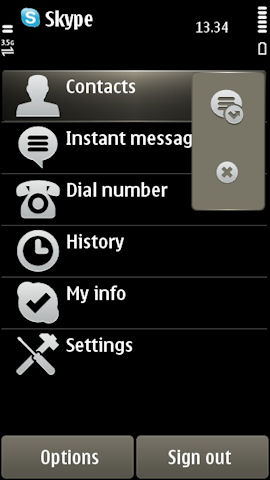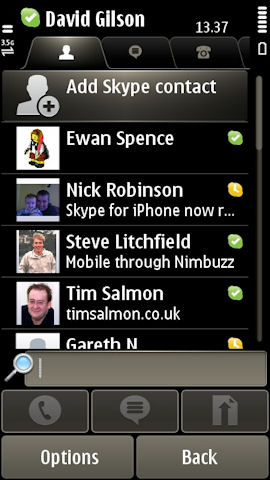Skype has around 170 million connected users (650 million+ registered users) and was used for 207 billion minutes of audio and video conversations in 2010. It is estimated that Skype is used for 15% of all international calls. Skype is a VoIP service (Voice over Internet Protocol) that uses a peer-to-peer system on the backend and is primarily used for instant messaging, audio and video calls.


Skype on Symbian^3
For Microsoft, Skype functionality could serve an important role in its enterprise communication and collaboration offerings, both as a standalone tool and a feature within the Microsoft Office suite of applications. Skype could be included in other Microsoft products too; it would be a logical addition to Microsoft's Xbox gaming systems, especially for those users with the Kinect accessory (which includes a video camera). In both of these cases Microsoft has existing communication technologies (Lync, Xbox Live respectively), but the Skype acquisition would bring in important technology, a greater ability to scale services, a large existing installed base and a well known brand name.
And of course there's the mobile dimension, which perhaps offers the greatest potential. Ultimately, communication is a core function for almost all mobile devices. Skype offers voice calling, instant messaging, video calling and sharing, all of which is delivered over an IP (data) connection.
Integration of Skype into Windows Phone is a given - Microsoft recently showed off a Skype application at their MIX developer conference. However, with the acquisition, Skype functionality and contacts could be more deeply integrated into the platform. For example, Skype could become a key enabler in the People hub, alongside Facebook, Twitter and Windows Live. This would mean both that Skype communication functionality (voice, video, IM, sharing) would be available and that Skype contacts would be integrated into the address book.
Given that Nokia's recent partnership with Microsoft specifically calls for the companies to work together to create a mobile ecosystem, it is also possible to foresee Skype functionality being built into Nokia's mobile phones (Series 40). Skype To Go and other Skype call routing methods allow any phone to be used to make Skype calls and Nokia's unmatched reach (100 million phones per quarter) offers a great deal of potential, if it can be successfully utilised.
Operators have traditionally been wary of Skype, fearing that it would cannibalise their own voice revenue. However, the service has gained a significant foothold with a number of major operators (Verizon, KDDI, Hutchinson 3) and is increasingly seen as a way for operators to differentiate their communication offering from rivals. Nonetheless, operator resistance will likely remain a significant barrier to the use of Skype services on mobile devices.
Steve Ballmer, Microsoft CEO, said:
"Skype is a phenomenal service that is loved by millions of people around the world. Together we will create the future of real-time communications so people can easily stay connected to family, friends, clients and colleagues anywhere in the world."
Tony Bates, Skype CEO and future president of the Microsoft Skype Division, said:
"Microsoft and Skype share the vision of bringing software innovation and products to our customers. Together, we will be able to accelerate Skype's plans to extend our global community and introduce new ways for everyone to communicate and collaborate."
More information in the Microsoft press release and on the Skype blog.
